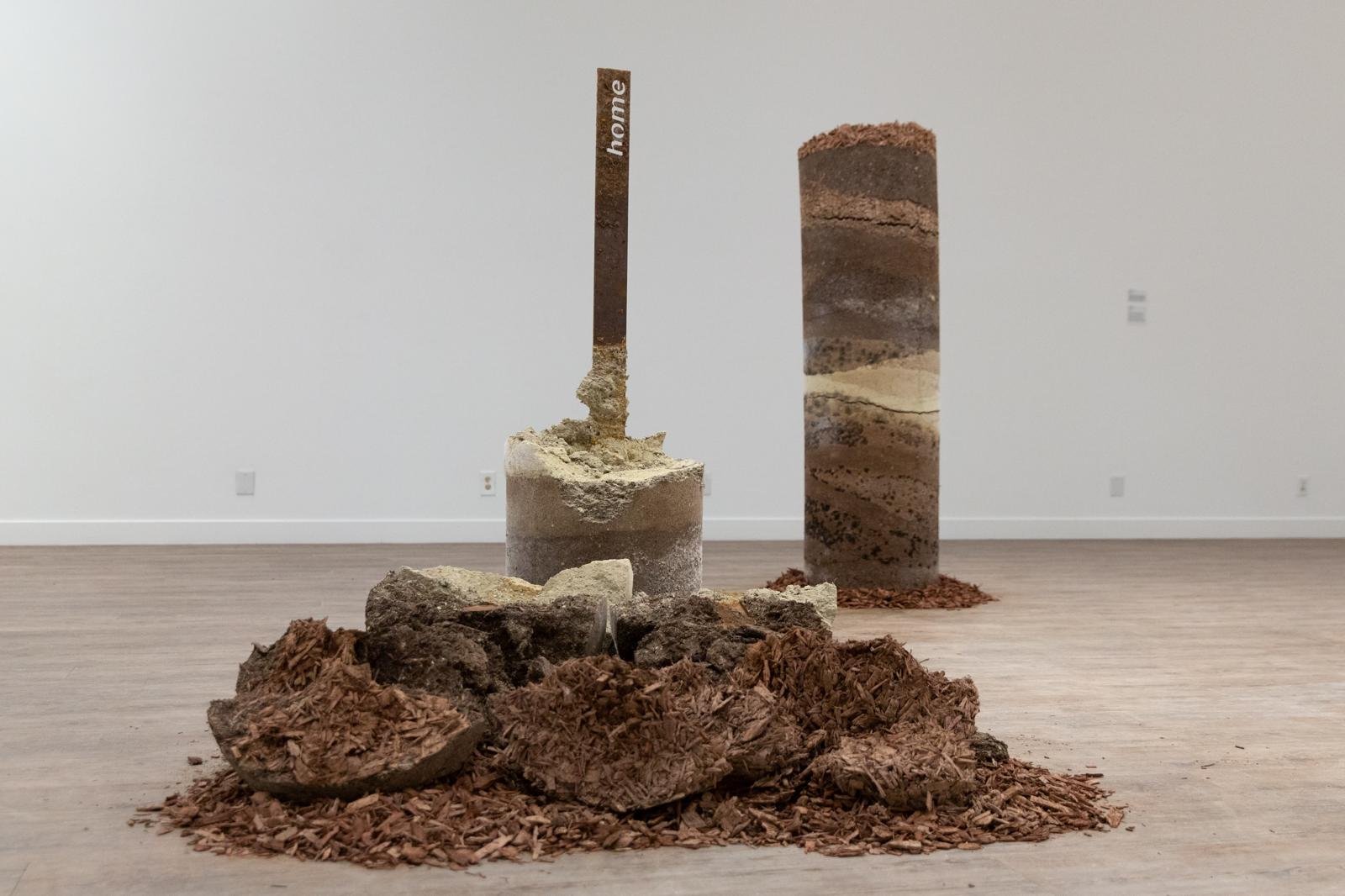
BOILING ROCKS
— 2024
SOIL PELLET MOSAICS, REMEDIATING SCULPTURES, VIDEO PROJECTION, PROSPERING BACKYARDS MEMORABILIA
Commissioned works for Sinks: places we call home. PST Art x Science Collide.
Boiling Rocks is a series of works whose name is derived from the origins of the mineral zeolite (Zeo Boiling Rocks is a series of works whose name is derived from the meaning of the mineral zeolite (Zeo “boiling,” lithos “stone”), which is a material used to remediate soil in a community science project called Prospering backyards (Pb). This project emerged from the research phase that the artist Maru García led for the exhibition Sinks: Places We Call Home in collaboration with the Natural History Museum of Los Angeles (NHMLA), Self Help Graphics, community members, and volunteers.
Pb addresses the severe case of lead contamination in the soil caused by Exide Technologies in areas of South East and East Los Angeles. In addition to community science research with zeolites, Pb teaches the community about soil health through a series of “Soil Time” workshops that collaborate with organizations working on soil health. Scholar Frida Cano writes about this work, “Pb operates under the principles of Indigenous worldviews by regarding the Earth as sacred (rather than an inexhaustible resource or a repository for waste). Human beings are not viewed as the protagonists of history and instead acknowledge their belonging to an interconnected and balanced system that prospers in community. Although it uses the language of Western science, Pb manages to build a bridge through art connecting the generative life force found in every living being.”
Boiling rocks 1
Boiling Rocks 1: Soil pellets mosaics, 30 x 30 in.
Boiling Rocks 1 is a series of mosaics featuring compressed pellets made of contaminated soil collected by community scientists in their own yards. These works represent research carried out to discover how zeolites reduce lead levels in the soil. The inspiration for this piece comes from the lead analysis method developed at the NHMLA laboratory, where soil samples were pulverized and compressed in pellets for use in an X-ray Fluorescence (XRF) Spectrometer.
a. Zeolite remediation
b. Zeolite microscopy
c. Activation with water



Boiling rocks 2
Video installation of microscopic imagery obtained by a Scanning Electron Microscope (SEM) of zeolites capturing lead. Collaboration with Dr. Aaron Celestian, head of the Mineralogy Department at the Natural History Museum of Los Angeles.
Zeolites are minerals that have the ability to ‘encapsulate’ lead, making it not harmful to humans when applied to the soil. More information about zeolites. Boiling Rocks 2 is a video of zeolites at the microscopic level using the Scanning Electron Microscope at the NHMLA. These microscopies demonstrate how the structure of zeolites captures lead. The brighter areas (white) show higher lead concentrations.



Boiling rocks 3
Remediating sculptures of soil, zeolites, compost, mulch, seeds, and steel. 30 in x 6 ft
Boiling Rocks 3 is a series of sculptures designed to remediate the soil in the process of disintegration. They are based on the core sampling process and the materials used in Prospering backyards for remediation.
Soil amendments are compressed in a monolithic structure supported by a steel pole in the center. Each pole has a laser-cut word revealing the meaning of soil to participants in the Soil Time! Workshops. These sculptures are designed to be released in parks or public spaces where lead has been found in the soil.
Boiling rocks 4
Prints of Community Scientists’ research installation, Prospering backyards memorabilia.
Boiling Rocks 4 is a collection of prints showing the testing sites at Community Scientists’ yards. The artist considers these structures to be collaborative site-specific installations. Boiling Rocks 4 also includes different elements from scientific research: working books, Pb uniforms, sampling instruments, and the Prospering Backyards report.
Acknowledgments
Self Help Graphics
Curator Marvella Muro, Ana Guajardo, Lulu Ordiales, Betty Avila and Nanci Ochoa
Natural History Museum of Los Angeles County
Dr. Aaron Celestian, Curator of the Mineralogy Department
Lila Higgins, Sam Tayag, and Miguel Ordeñana, Community Science Department
Academic collaborators
Dr Maura Palacios, Mt San Antonio College
Dr. Jeffrey Cole, Pasadena City College
Dr. Levi Simons, UC Santa Cruz
Prospering backyards: team and volunteers
Graham Smith, Rachel Cellinese, Jordan Salcido
David Velez, Zoe Blaq, Paola Reyes
Prospering backyards: Community Scientists
Lupe, Michelle, Miguel, KR, Sonia, Xochitl, Vilma, Martha, Jenni, Reyna, Joel, Jacqui, Elena

































